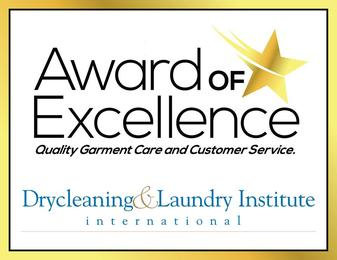 An Award of Excellence Dry Cleaner since 2005
An Award of Excellence Dry Cleaner since 2005

 An Award of Excellence Dry Cleaner since 2005
An Award of Excellence Dry Cleaner since 2005

GOOD dry cleaners are responsible operators and individuals who care about their customers, the environment and their employees. The cleaners treats their employees well and maintains a safe working environment.
TRADE associations like the Iowa/ Nebraska Fabric Care Association and the International Fabricare Association are important to us all. These associations filter relevant information to their members about fashion and fibers, the laws and regulations pertaining to the fabric care industry and channels trade magazines to its member.

ENVIRONMENTAL concerns are always on top of all good dry cleaners minds. Good cleaners follow responsible fabricare. They follow safe handling of all chemicals including cleaning solvents. Good dry cleaners remove their filters and waste products using a government licensed hauler to an accepted and approved waste facility. Good dry cleaners keep manifests of all restricted byproducts that are taken to waste facilities. Good dry cleaner uses no less than fourth generation dry-cleaning machines to minimize negative impact on the environment. Good dry cleaners exceed the minimum plant air quality standards as posted by OSHA and EPA. Their plants do not smell of solvents or chemicals.
ATTENTION to detail is always important. Does the dry cleaners get the stain out? Does the cleaner ask for a release from the customer for garments with no care labels or with special trim? Care labels are important because they contain important information from the manufacturer on how to properly service their garments so the customer can have many years of enjoyment and use from them. Trim may pose problems for cleaners because sometimes the manufacturer applies them to garments after the care label had been attached to the garment. The trim then may not withstand the cleaning process. A good dry cleaner will often recognize these conditions and, prior to cleaning discuss the concerns with the customer and suggest alternatives in the cleaning process.
GARMENTS are returned to customers wrinkled free. Garments are not damaged at the stain sites. The good cleaner knows to be cautious and stop before damage occurs in stain removal. Garments are inspected before they're returned to the customers. Many garments are not placed in the same poly bag to prevent re-wrinkling due to crushing. Tags are not stapled through clothes in order to avoid damage and are removed before returning the garments to the customer.
QUALITY is often advertised but not so often found in many dry cleaners operation and products. What to look for in determining quality includes a neat appearance and clean call office and plant, friendly knowledgeable employees dressed professionally and prepared to handle question, even tough ones. They should have the ability to handle problems which arise in any aspect of customer service. Are the products done right and ready on time as promised? Is their dialogue with customers regarding problems and potential problems before they arise? Do clean clothes look right on the hangers? Are they lint free? Are buttons replaced free if broken or lost? Are all loose threads trimmed? Does the cleaners use special hanger forms to keep garments looking right? Do the garments smell fresh and clean? To the touch, is the natural feel present? Does the cleaner use hanger covers to both advertise and protect the customers garments. Does the cleaners offer technical information? Is there a Fabricare library of material available to the customers? Is there evidence of the importance of educating the customer about care, cleaning and wearing garments? Are computers used in making the operation efficient and timely?
EDUCATION is a critical ingredient for the dry cleaner and his/her employees. With the enormity of new fabrics reaching the market, changing technologies, new chemical procedures, a dry cleaner, along with his staff, must keep current in the field. Evidence of training should be seen in the plant and call office. Dry cleaners are proud of their credentials and often display them for customers to see. Specialized certifications like Certified Professional Dry cleaner, Certified Environmental Dry cleaner, Certified Wet Cleaner represent advanced levels of training often not found in dry cleaners establishments.
MISSION and vision are important aspects of the dry cleaners focus on service, quality and the customer. Mission statements are often available for view in the plant and are sometimes printed on customer tickets.
CUSTOMER SERVICE is important. Does the drycleaner make promises that he/she cannot keep? Are your clothes ready when promised? If a problem does occur, does the cleaner try to work them out with the customer. If a claim does occur, do they use the industry-accepted guide to determine fair value like the international Fabricare Fair Claims Guide?
CUSTOMER SATISFACTION is a critical area for any business and a good drycleaner is always sensitive to the needs of the customer. Information is often gathered from customers through surveys and questionnaire, phone calls, etc. to insure that key ingredients of service are always present and always improving.
COMMUNITY involvement is often a characteristic found in well-operated dry-cleaning establishments. Chamber of commerce, better business bureaus, children's events, community event sponsorship are often found as indicators of a drycleaner community involvement. Sponsorship of the local church directory, theater productions, and charity are often areas of involvement of good dry cleaners.
TESTING, when needed, occurs on an unexposed seam and is performed on an item when no care label exists or a processing concern is brought to the cleaner's attention. A good drycleaner classifies every load of garments to be cleaned by color and material to insure the proper cleaning techniques.
CHEAPER isn't always better. A big danger to clothes is a cleaner who tries to cut cost by cutting corners. Quality cleaners add special detergents and sizing to their solvent to enhance the cleaning ability and give the clothes additional body and feel. Solvent is distilled after every lead in order to clean solvent to be used in every cleaning. Filters are used to remove any impurity and soil that the solvent picks up as it passes through the garments.
TECHNOLOGY is ever changing. A good drycleaner will use current technologies in spot removal, in the cleaning process, in repairing garments, in stain removal, in computer applications for marking, tracking, and locating garments. Current customer's lists enable a good drycleaner to track business activity and to communicate with his customers.
Send us your email address, if you would like to receive monthly online coupons.